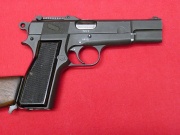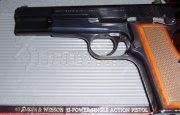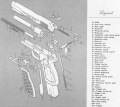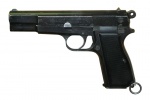Difference between revisions of "Browning Hi-Power"
(fixing?) |
m (1 revision) |
Latest revision as of 14:24, 15 March 2013
| Browning Hi-Power | |
|---|---|

| |
| Belgian Army Browning | |
|
| |
| Type | Semi-automatic pistol |
| Land of Origin | Belgium / USA |
| Specifications | |
| Length | 200 mm (7.87") |
| Barrel length | 118mm (4.64") |
| Caliber | variable |
| Cartridge | 7.65mm Parabellum 9x19mm Parabellum .40 S&W .357 SIG |
| Action | Short recoil operated |
|
| |
| Rate of Fire | semi-auto |
| Muzzle velocity | 1,148 ft/s (350 m/s) |
| Feed | 13-round box magazine |
| Service History | |
| In service | 1930s-present |
| Used by | See Users |
| Production History | |
| Designer | John Browning, Dieudonne Saive |
| Design Date | 1921–1935 |
| Manufacturer | numerous; see article |
| Unit Cost | ~US$750-$1000[1] |
| Variants | see: Models |
The Browning Hi-Power is a single-action, 9 mm semi-automatic pistol. It is based on ideas conceived and patented in 1922 by American firearms inventor John Browning, and later patented by Fabrique Nationale (FN) of Herstal, Belgium. Browning died in 1926, before he had finished developing a production version. The design was fully developed and realized by Belgian arms designer Dieudonne Saive, working at FN.
The Hi-Power pistol was named for its 13-round magazine capacity, which was almost twice that of contemporary designs such as the Luger or Mauser 1910. The Hi-Power had the first functional double-column magazine of 9 mm rounds, and was capable of holding 13 cartridges, with a 14th loaded in the chamber. Flush-fit 15 round magazines are now available, as well as higher capacity magazines which extend past the end of the butt.
The pistol is often referred to as an HP (for "Hi-Power" or "High-Power"[2]) or as a GP (for the French term, "Grande Puissance"). The term P-35 is also used, based on the introduction of the pistol in 1935. Another common nickname is the "King of Nines."[3] It is most often called the "Hi-Power", even in Belgium. It is also known as the BAP (Browning Automatic Pistol), particularly in Irish service.
Contents |
[edit] Development
The Hi-Power was designed in response to a French military requirement for a new service pistol, the Grand Rendement (French for "High Yield"), or alternatively Grande Puissance (literally "high power"). The French military's requirements were that the arm should be compact, have a capacity of at least 10 rounds, a magazine disconnect device, an external hammer, a positive safety, be robust and simple to disassemble and re-assemble, and be capable of killing a man at 50 metres; this last criterion was seen to demand a calibre of 9 mm or larger, a bullet mass of around 8 grammes, and a muzzle velocity of 350 m/s. It was to accomplish all of this at a weight not exceeding 1 kg (2.2 lb).
FN commissioned John Browning to design a new military sidearm conforming to this specification. Browning had previously sold the rights to his successful M1911 U.S. Army automatic pistol to Colt's Patent Firearms, and was therefore forced to design an entirely new pistol while working around the M1911 patents. Browning built two different prototypes for the project. One was a simple blowback design, while the other was operated with a locked-breech recoil system. Both prototypes utilized a new staggered magazine design to increase capacity without unduly increasing the pistol's grip size or magazine length.
The locked breech design was selected for further development and testing. This model was striker-fired, and featured a double-column magazine that held 16 rounds. The design was refined through several trials held by the Versailles Trial Commission.
In 1928, when the patents for the Colt Model 1911 had expired, Dieudonne Saive integrated many of the Colt's previously patented features into the Grand Rendement design, in the Saive-Browning Model of 1928. This version featured the removable barrel bushing and takedown sequence of the Colt 1911.
By 1931, the Hi-Power design incorporated a shortened 13-round magazine, a curved rear gripstrap, and a barrel bushing that was integral to the slide assembly. By 1934, the Hi-Power design was complete and ready to be produced. It was first adopted by Belgium for military service in 1935 as the Browning P-35. Ultimately, France decided not to adopt the pistol, instead selecting the conceptually similar Mle. 1935.
[edit] Design features
The Browning Hi-Power has undergone continuous refinement by FN since its introduction. The pistols were originally made in two models: an "Ordinary Model" with fixed sights and an "Adjustable Rear Sight Model" with a tangent-type rear sight and a slotted grip for attaching a wooden shoulder stock. The adjustable sights are still available on commercial versions of the Hi-Power, although the shoulder stock mounts were discontinued during WW2. In 1962, the design was modified to replace the internal extractor with an external extractor, improving reliability.
Standard Hi-Powers are based on a single-action design. Unlike modern double-action semi-automatic pistols, the Hi-Power's trigger is not connected to the hammer. If a double-action pistol is carried with the hammer down with a round in the chamber and a loaded magazine installed, the shooter may fire the pistol by simply pulling the trigger. In contrast, a single-action pistol must be cocked manually before the first shot, either by thumbing the hammer back, or by pulling the slide to the rear and releasing it. In common with the M1911, the Hi-Power is therefore typically carried with the hammer cocked and the safety catch on (a carry mode often called cocked and locked, or sometimes called condition one).
The Hi-Power, like many other Browning designs, operates on the short-recoil principle, where the barrel and slide initially recoil together until the barrel is unlocked from the slide by a camming action. Unlike Browning's earlier Colt M1911, the barrel is not moved vertically by a toggling link, but instead by a hardened bar which crosses the frame under the barrel and contacts a slot under the chamber, at the rearmost part of the barrel. The barrel and slide recoil together for a short distance but, as the slot engages the bar, the chamber and the rear of the barrel are drawn downward and stopped. The downward movement of the barrel disengages it from the slide, which continues rearward, extracting the spent case from the chamber and ejecting it. After the slide reaches the limit of its travel, the recoil spring brings it forward again, stripping a new round from the magazine and pushing it into the chamber. This also pushes the chamber and barrel forward. The cam slot and bar move the chamber upward and the locking lugs on the barrel reengage those in the slide.
The Hi-Power has two flaws. The standard trigger pull is heavy, especially for a single-action pistol. This disadvantage is a consequence of the Hi-Power's magazine safety design, which was initially added to the model to meet the requirements of the French military in 1935. The standard Hi-Power magazine safety is connected to the trigger and is released by a plunger pressing on the surface of the magazine. This action of the plunger on the magazine adds tension to the trigger pull, and the required force to operate this feature adds resistance as well. This problem is often resolved by removing the magazine safety entirely, thus voiding the pistol's warranty, or by polishing the interface surfaces between the safety plunger and the magazine. After-market trigger springs with reduced tension are also available to improve the trigger pull.
In addition, the pistol has a tendency to "bite" the web of the shooter's hand, between the thumb and forefinger. This bite is caused by pressure from the hammer spur, or alternatively by pinching between the hammer shank and grip tang. Many HP owners fix this problem by altering or replacing the hammer, or by learning to hold the pistol to avoid injury. While a common complaint with the commercial models with spur hammers similar to that of the Colt "Government Model" automatic, it is seldom a problem with the military models, which have a smaller, rounded "burr" hammer, more like that of the Colt "Commander" compact version of the 1911.
[edit] Military service
Browning Hi-Power pistols were used during World War II by both the Allied and the Axis powers. Belgium was occupied by the Axis powers early in the war, and FN's plant was seized by Nazi Germany. The German armed forces used the Hi-Power as the Pistole 640(b) ("b" for belgisch, "Belgian"). Examples produced by FN in Belgium under German occupation bear a German inspection and acceptance mark, or Waffenamt, such as WaA613.
Hi-Power pistols were also produced in Canada for Allied use, by John Inglis and Company. The pistol was popular with covert operations and commando groups such as the U.S. Office of Strategic Services (OSS) and the nascent British SAS (Special Air Service) Regiment. In the post-war period, Hi-Powers remained popular among military forces, with over 50 armies (93 nations) issuing this design since its invention. Former Iraqi ruler Saddam Hussein often carried a Browning Hi-Power, as did many Iraqi military officers.
As of 2007, the MK1 version is currently in service with the Canadian Forces, supplemented by the Sig Sauer P226. The weapon is the standard sidearm of the Belgian Army, British Army, Indian Army, Australian Defence Force, Argentine Army, Irish Army, Luxembourgish Army, Israeli police, Singapore Special Operations Force and Venezuelan Army, among others. The Irish Army has begun replacing its Browning Pistols (known popularly as BAPs, or Browning Automatic Pistols) with the H&K USP automatic in 2007.
[edit] Example: technical description of the Mark I
A locked-breech, semi-automatic, single-action, recoil-operated pistol. The Browning Hi-Power Mk I uses a 13-round staggered magazine.
Specifications:
- Caliber: 9 mm
- Length: 197 mm
- Barrel length: 118 mm
- length of rifled part: 100 mm
- number of grooves: 6
- direction of twist: right
- Height (without sight, loaded): 127.5 mm
- Width (with stocks): 36 mm
- (without stocks): 25.5 mm
- Weight (with empty magazine): 0.9 kg
- (with loaded magazine): 1.060 kg
- Capacity of magazine: 13 cartridges
- Modes of fire: Single action
- Muzzle velocity: 350 m/s
- v. 12.50: 340 m/s
- muzzle energy: 50 kgm
- Safeties: Half-cock notch, manual thumb safety, firing pin block, and magazine disconnect
- Trigger pull: 7.5 lb
- Maximum Effective Range: 50 m
- Dispersion (firing 10 shots with rest)
- at 15 metres: 95 mm (height 50mm, width 45mm)
- at 30 metres: 200 mm (height 105mm, width 95mm)
- at 50 metres: 320 mm (height 170mm, width 150mm)
[edit] Models
Genuine Browning Hi-Power P35s are still manufactured by FN Herstal of Belgium and Portugal, and under license by Fabricaciones Militares (FM) of Argentina. The Hi-Power remains one of the most influential pistols in the history of small arms. It has inspired a number of clone manufacturers (including Charles Daly of the Philippines & USA, FEG of Hungary, Arcus of Bulgaria, and others) who borrow features from it, chiefly the linkless cam system. Until recently, FEG made an almost exact clone, but the company now manufactures a version with modifications to the barrel, linkage, and slide stop that are incompatible with genuine Hi-Powers.
- The original P35, as noted earlier, featured an internal extractor. During WWII, it was manufactured by Inglis of Canada for allied use, and by FN in occupied Belgium for German use. Most Canadian P35s were manufactured with a parkerized finish, while most P35s manufactured in occupied Belgium had a blued finish. The internal extractor was replaced with a more durable external extractor in the early 1960s.
- The Browning L9A1, a military version of the P35 Hi-Power, is still utilized by several branches of the UK military forces. The Hi-Power was the pistol of choice for the British Special Air Service (Special Forces), throughout the Cold War era.
- The Mark I is among the best-known models of the P35 developed over the last 50 years. A wide variety of options and features are available on the P35 models. Recently, Hi-Power pistols have become available in the .40 S&W and .357 SIG loadings. However, the use of these calibers in guns designed and built for 9x19mm Parabellum has created cases of broken or warped frames. Only Hi-Powers specifically built for these rounds should be used to fire them. The pistols manufactured for these two rounds are easily identified by examining the left side of the slide - a groove is machined into the side of the heavier slide to allow clearance for the slide release.
- The Mark I Lightweight is a very rare variant of the Mark I made with a lightweight alloy frame. According to Massad Ayoob, these were introduced commercially in the 1950's but never caught on. The Lightweights are only marked with Fabrique Nationales' rollmarks, not Brownings.
- Mark II is an upgraded model of the original Hi-Power introduced in the early '80s. Some of the upgrades were ambidextrous thumb safeties, nylon grips, 3-dot sights, and a throated barrel.
- Mark III was another advancement over the Mark II released in 1988, which featured a firing pin safety and grips similar to the M9 pistol. The Standard is an original Hi-Power with the Mark III firing system. The Capitan and Practical are also slightly different configured Mark IIIs.
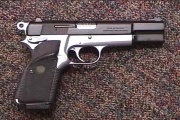
- The Practical features a matte-blued slide and contrasting silver-chromed frame. In addition, this model has Pachmayr rubber grips and a rounded Commander-style hammer. The Practical has fixed or adjustable sights, and is available in either 9mm or .40 S&W. Magazines for all Practical models sport Pachmayr base pads; magazines feature a cartridge capacity of 13 rounds in 9mm and a cartridge capacity of 10 rounds in .40 S&W. [4]
- The HP-SFS (Safe-Fast-Shooting) is a current variation on the Hi-Power Mark III with a modified firing mechanism. After the weapon is loaded, the hammer is pushed forward, which automatically activates the safety catch. When the shooter is prepared to fire, the safety is pressed down with the thumb, releasing the hammer to spring backwards into the usual, single-action position. A similar system is available for modifying Colt M1911A1s. Magazines are interchangeable with the Mark III and others.
- The Detective is a short-slide HP produced by FM. The Detective slide group is also available without the frame, and is interchangeable with other FM and FN Hi-Power P35s.
- The BDA and BDAO models were first produced in the 1980s by FN. The BDA model is double action, and the DAO model is "double action only," both versions differing from the usual single-action operation of the P35. These designs have been marketed as the HP-DA and BDA. The DA and DAO models retain many features of the P35, and both are available in full-sized and compact versions. Performance of these models is consistent with FN's high standards. These models resemble the P35, but the most distinguishing feature is the extended SIG-Sauer style trigger guard. Many parts are interchangeable with the P35, but the magazines (although similar) are not. The compact versions also utilize shorter magazines.[4]
The Browning BDM Model is sometimes erroneously attributed as a special model of the Hi-Power family of pistols. However, this is actually a unique pistol design only bearing an external similarity to the Hi-Power. The BDM was produced during the 1990s only in North America by Browning Arms Company, and not by FN. The Browning BDM (Browning Double Mode) pistol incorporates many features of the BDA model, but can be switched from double action/single action mode to "revolver" mode (DAO) by the flip of a slide mounted switch.
- Both the DA / DAO models and the BDM model borrow features from the SIG-Sauer SIG P220 pistols marketed under the name Browning Double Action (BDA) in the 1970s. The Beretta 84 has also been marketed by Browning under the name BDA 380.
[edit] Users
|
|
[edit] Resources
[edit] Online documents
The GOR online library has the following documents available for free download for the Browning Hi-Power and its variants:
- Browning Hi-Power Owner's Manual by Browning (3.6MB .PDF file, 16pgs)
- Browning High Power Owner's Manual by FN (1.2MB .PDF file, 17pgs)
- Browning BDA & BDAO Owner's Manual (9,8MB .PDF file, 34pgs)
- Browning DA140 Owner's Manual (17.5MB .PDF file, 30pgs)
- Browning GP Owner's Manual (7.2MB .PDF file, 26pgs)
- Browning GP Competition Owner's Manual (6.8MB .PDF file, 26pgs)
[edit] Diagrams
The following images are also available for reference (see also: Category:Browning pistol diagrams):
[edit] Historical data
The 9mm Hi-Power pistol was introduced to the U.S. market in 1954. Serial numbers from 1954 through 1957 are estimates only. From 1958 on, better records were kept and the serial numbers are more accurate. The 40 S&W caliber was introduced in 1994This pistol is still in production today.
To find your serial number, you will need to refer to your owner's manual (see Online documents, above).
| DATE | HISTORIC INFORMATION | SERIAL NO. INFO | |||||||
|---|---|---|---|---|---|---|---|---|---|
| 1954-57 | The Hi-Power 9mm pistol was introduced in 1954. | 70000-80,000 Accurate production figures are unavailable. | |||||||
| 1958 | In 1958 Browning kept better records of the Hi-Power pistol, so the serial number ranges are more accurate | 80001-85276 | |||||||
| 1959 | 85268-89687 | ||||||||
| 1960 | 89688-93027 | ||||||||
| 1961 | 93028-109145 | ||||||||
| 1962 | 109146-113548 | ||||||||
| 1963 | 113549-115822 | ||||||||
| 1964 | In 1964 the product code for the Hi-Power was the letter "T" | 115823-T136-568 | |||||||
| 1965 | T136569-T146372 | ||||||||
| 1966 | T146373-T173285 | ||||||||
| 1967 | T173286-T213999 | ||||||||
| 1968 | T214000-T258000 | ||||||||
| 1969-75 | In 1969 Browning started using two digits for the date of manufacture which was followed by a four digit code that identified the type of Hi-Power: C=Hi-Power This was then followed by the serial number beginning with 1000. Example: 69C1000 = A 1969 Hi-Power pistol with a serial number of 1000. |
T258001-261000 C=Hi-Power | |||||||
| 1976-1997 |
|
Serial Number Example: 245RT01001 This would be a 9mm Hi-Power pistol, manufactured in 1976 with the serial number 01001. | |||||||
| 1998 |
|
Serial Number Example: 510NN01001 This would be a 9mm Hi-Power pistol, manufactured in 1999 with the serial number 01001. | |||||||
[edit] Notes
- ↑ MSRP varies by specific model variant; customizations will, obviously, increase the price.
- ↑ Browning Catalog
- ↑ The American Historical Foundation, The WORLD WAR II BROWNING HI-POWER commemorative
- ↑ 4.0 4.1 Fabrica Militar Fray Luis Beltrán (FMFLB) Myaflb.com.ar
[edit] References
- The Browning High Power Automatic Pistol, by R. Blake Stevens (Collector Grade Publications, 1990)
- FN Hi-Power Explained by Gerard Henrotin (H&L Publishing, 2004)
[edit] External links
- HiPowers and Handguns
- Browning Hi-Power Owners Forum
- F.N. mod. G.P. (Grande Puissance) pictures
- The Browning High Power Automatic Pistol by R. Blake Stevens
[edit] Manual
| This article is part of a series on the works of John Moses Browning | ||
|---|---|---|
| Semi-automatic pistols | FN M1900 · Colt M1900 · Colt M1902 · FN Model 1903 · M1903 Pocket Hammer · M1903 Pocket Hammerless · M1908 Vest Pocket · FN Model 1910 · M1911 · Colt Woodsman · Baby Browning · Hi-Power | 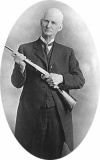 |
| Rifles | Winchester Model 1885 · Winchester Model 1886 · Winchester 1892 · Winchester Model 1894 · Winchester Model 1895 · Remington Model 8 · Remington Model 24 · FN Trombone | |
| Shotguns | Winchester Model 1887 · Winchester Model 1897 · Browning Auto-5/Remington Model 11 · Remington Model 17 · Savage Model 520 · Browning Superposed · Ithaca 37 | |
| Machine guns | Colt-Browning M1895 · Browning M1917 · Browning Automatic Rifle · Browning M1919 · M2 Machine Gun | |
| Cartridges | .25 ACP · .32 ACP · .38 ACP · .380 ACP · .45 ACP · .50 BMG | |
| This article is part of a series on FN Herstal firearms | ||
|---|---|---|
| Handguns | Barracuda · Five-seven · FNP series/FNX series · Forty-Nine · Hi-Power · HP-DA · M1900 · M1903 · M1905 · M1910 | |
| Rifles | Semi-auto & select — C1 · CAL · F2000 / FS2000 · FAL · FNAR · FNC · Model 1949 · PS90 · SCAR-L/SCAR-H Bolt-action — Model 1950 · Model 30-11 · PBR · SPR · TSR | |
| Shotguns | SLP · TPS | |
| Submachine guns | P90 | |
| Machine guns | BRG-15 · M2 · MAG· Minimi · Mle 1930 | |
| Other stuff | 5.56x45mm SS109 · 5.7x28mm · EGLM · FN 303 | |
| Side Arms | Webley Mk IV & Mk VI Revolvers· Enfield No. 2 Mk I Revolver· Browning GP-35 "High Power" Pistol· Smith & Wesson "Victory" Revolver· Welrod | |
|---|---|---|
| Rifles & submachine guns | SMLE No.1 Mk III* & Lee-Enfield No.4 Mk.I· Lee-Enfield No.5 Mk.I "Jungle Carbine"· De Lisle Commando Carbine· Sten SMG· Lanchester SMG· Austen SMG· Owen Gun· Welgun | |
| Machine-guns & big stuff | Bren gun· Charlton Automatic Rifle· Lewis Gun· Vickers MG· PIAT· Rifle, Anti-Tank, .55 in, Boys· SBML 2inch Mortar· ML 3-inch Mortar· No.2 "Lifebuoy" Flamethrower | |
| Grenades | British grenades of WWI and WW2 · Mills Bomb | |
| Small arms cartridges | .303 British· 9mm Parabellum· .45 ACP· .455 Webley· .38/200· .38 Special· .50 BMG | |


